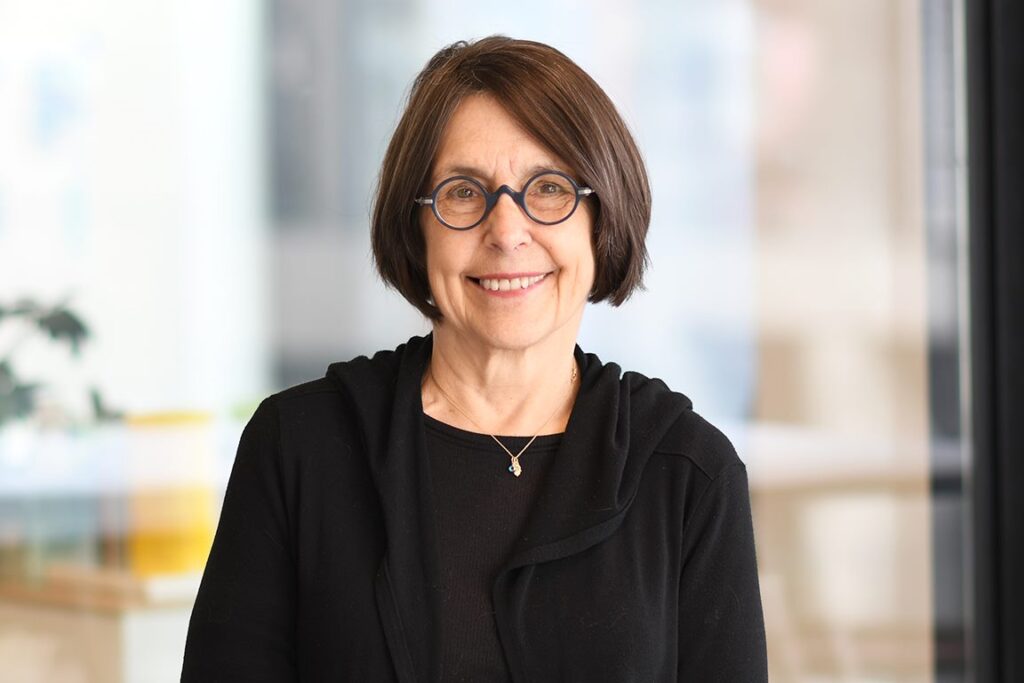Robin Guenther, a principal at Perkins&Will and a global leader in sustainable healthcare design, died May 6 in New York City after a prolonged battle with cancer. She was 68 years old.
The architect
Guenther was a pioneer in the field of architecture; her work focused on the intersection of sustainability policy and health design. She directed the sustainable design strategies of numerous innovative healthcare projects in the U.S. and abroad.
Her impact on the practice of architecture extended well beyond the projects she personally worked on. She played a key role in the development of Perkins&Will’s 2008 Precautionary List, a public compilation of substances of concern commonly found in building products worldwide. Revolutionary for its time, the Precautionary List helped ignite an industry movement toward healthier built environments and more transparent product manufacturing.
Guenther and her team later helped create the Transparency website, which — in addition to hosting the Precautionary List — provides chemical descriptions, data on human and environmental health hazards, information on ways people can be exposed to those chemicals, relevant government regulations and industry rating systems and associated building products.
The activist
Outside of practicing architecture, Guenther was a tireless advocate for regenerative design and inspired legions of fellow architects, clients, and others to be better stewards of the planet and humankind. She was a senior advisor for Healthcare Without Harm, a nonprofit that seeks to reduce the environmental impact of hospitals and turn them into exemplars of sustainability and coordinated the organization’s Green Guide for Healthcare, the sector’s first quantifiable sustainable design, construction and operations toolkit.
Guenther contributed regularly to CleanMed. She also served on the LEED for Healthcare committee and was an author, along with Gail Vittori, of Sustainable Healthcare Architecture, which includes case studies, essays, healthcare system profiles and research.
“Robin was a giant who I had the privilege to collaborate with for over two decades,” says Vittori, who today co-directs the Center for Maximum Potential Building Systems in Austin, Texas. “As with many, she inspired me to do more than I ever thought possible, recognizing that the work at hand had the potential to change people’s lives and the world for the better. Robin lived her life with remarkable optimism and hopefulness, and with grace. She will forever be a guiding light; I will miss her.”
An early start
Guenther was born on Oct. 2, 1954, in Detroit, Michigan. It was during a drive with her parents through downtown in 1962 that she realized architecture was her calling. She was just 8 years old, but something about the buildings she saw made her want to grow up to design her own. What she didn’t know then is that she would design some of the most important healthcare buildings of modern times.
As a teenager, Guenther had an after-school job that finished late at night. To avoid walking home alone, she would go straight to the nearby Detroit General Hospital, where her sister was a nurse in the ER. Every night, Guenther’s sister would drive her back home when her ER shift was up, but while waiting, she would finish her homework in the ER staff lounge, or volunteer around the hospital. Many years later, when Guenther took her first real job at a healthcare design firm, her colleagues were amazed by her vast knowledge of how hospitals operate — especially emergency departments. Guenther studied architecture at the University of Michigan and the Architectural Association in London. In 1979, after completing her degrees, she moved to New York City, where she took her first job at Norman Rosenfeld Architects.
In 1991, Guenther co-founded Guenther Petrarca, an architecture firm specializing in healthcare and sustainability, which became Guenther 5 Architects in 2001. It employed 18 people in 2007 when it merged with Perkins&Will. She served in several leadership roles at Perkins&Will, most recently as chair of the firm’s global health practice.
Legacy
She is survived by her husband, Perry Gunther, an artist and psychotherapist; two daughters, Jyllian Gunther and Nicole Marie Palms; two sisters, Lynn Monahan and Sharon Barnes; and many nieces and nephews. In lieu of flowers, donations may be made to Circle of Friends for the Dying and Commonweal Cancer Help Program.





